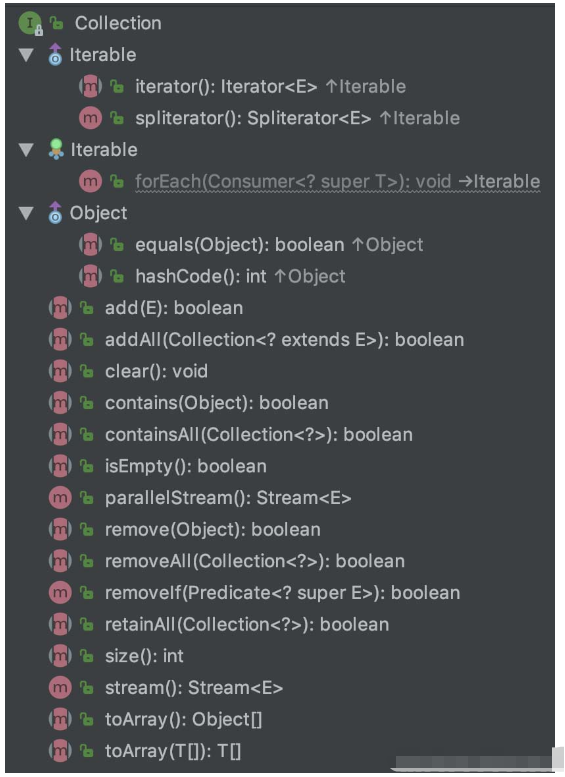这篇文章主要介绍了java集合Collection常用方法有哪些的相关知识,内容详细易懂,操作简单快捷,具有一定借鉴价值,相信大家阅读完这篇java集合Collection常用方法有哪些文章都会有所收获,下面我们一起来看看吧。
提到集合就不得不提一下数组,好多集合底层都是依赖于数组的实现。数组一旦初始化后,长度就确定了,存储数据对象不能达到动态扩展,其次数组存储元素不便于对数组进行添加、修改、删除操作,而且数组可以存储重复元素。
这个时候集合对作用显现出来了。
集合分为Collection和Map两种体系。
下面先介绍Collection的集合类的继承树如下图所示:

Collection接口是 (java.util.Collection)是Java集合类的顶级接口之一,整个集合框架就围绕一组标准接口而设计。
Collection 接口有 3 种子类型集合: List、Set 和 Queue,再下面是一些抽象类,最后是具体实现类,常用的有 ArrayList、LinkedList、HashSet、LinkedHashSet、ArrayBlockingQueue等,下面是Collection的所有方法。

这些方法即可以操作Set集合,也可以操作Queue和List集合,下面分别使用Collection集合接口的方法说明
| 方法名 | 说明 |
|---|---|
| boolean add(E e) | 向集合添加元素e,若指定集合元素改变了则返回true |
| boolean addAll(Collection<? extends E> c) | 把集合C中的元素全部添加到集合中,若指定集合元素改变返回true |
| void clear() | 清空所有集合元素 |
| boolean contains(Object o) | 判断指定集合是否包含对象o |
| boolean containsAll(Collection<?> c) | 判断指定集合是否包含集合c的所有元素 |
| boolean isEmpty() | 判断指定集合的元素size是否为0 |
| boolean remove(Object o) | 删除集合中的元素对象o,若集合有多个o元素,则只会删除第一个元素 |
| boolean removeAll(Collection<?> c) | 删除指定集合包含集合c的元素 |
| boolean retainAll(Collection<?> c) | 从指定集合中保留包含集合c的元素,其他元素则删除 |
| int size() | 集合的元素个数 |
| T[] toArray(T[] a) | 将集合转换为T类型的数组 |
下面是主要方法的演示:
@Test
@SuppressWarnings("all")
public void testCollection() {
// 创建Collection接口的实现
Collection collection = new ArrayList<>();
// 添加元素
collection.add("嘻嘻");
String src = "????";
collection.add(src);
System.out.println(collection);
// 创建Collection的实现
Collection<String> coll = new HashSet<>();
coll.add("?");
coll.add("?");
coll.add("?");
System.out.println(coll);
// 添加一个集合数据
collection.addAll(coll);
// 输出集合的长度
System.out.println(collection);
// 判断是否包含
System.out.println(collection.contains("?"));
// 移除元素
collection.remove("?");
// 添加对象
collection.add(new Person("张三", 23, 5000d));
// 当认为两个对象属性一致,相等时候,需重写hashCode 和 equals方法
System.out.println(collection.contains(new Person("张三", 23, 5000d)));
System.out.println("-------");
collection.add(null);
Collection<String> collection1 = new ArrayList<>();
collection1.add("嘻嘻");
collection1.add("?");
// 求两个集合的交集(只保留collection1存在的元素)
collection.retainAll(collection1);
System.out.println(collection);
// 清空元素
collection.clear();
System.out.println(collection);
}使用lambda表达式遍历集合
java8为Collection的父接口(Iterable)提供了一个默认的Foreach方法,我们可以使用它进行集合遍历,若对lambda不太了解,不妨访问一下这篇文章☞ lambda表达式学习
@Test
public void testForeach() {
Collection<String> collection = new ArrayList<>();
collection.add("i");
collection.add("love");
collection.add("china");
// foreach遍历
collection.forEach(e-> System.out.println(e));
// 可以使用方法引用简写
collection.forEach(System.out::println);
// 或者迭代器的forEachRemaining方法
collection.iterator().forEachRemaining(System.out::println);
}使用java8的predicate操作集合
@Test
public void testPredicate() {
Collection<Integer> collection = new ArrayList<>();
// 添加0-49
for (int i = 0; i < 50; i++) {
collection.add(i);
}
// 移除10-49的数字
collection.removeIf(e -> (e > 9 && e < 50));
System.out.println(collection);// 输出[0, 1, 2, 3, 4, 5, 6, 7, 8, 9]
}基于流操作集合
java8之后引入了Stream相关流操作java集合,通过流大大简化了对集合操作,关于这些流式操作,可以查看这篇文章☞ Stream入门学习,下面是基于流的一些简单演示:
@Test
public void testIntStream() {
Collection<Integer> collection = new ArrayList<>();
Random random = new Random();
for (int i = 0; i < 10; i++) {
collection.add(random.nextInt(100));
}
System.out.println(collection);
// collection存储的数值是包装类型,可以将其转换为IntStream
IntStream intStream = collection.stream().mapToInt(e -> e);
// intStream.forEach(System.out::println);
System.out.println(collection.stream().mapToInt(e -> e).sum());
// 输出最大值
collection.stream().mapToInt(e -> e).max().ifPresent(System.out::println);
// 输出最小值
collection.stream().mapToInt(e -> e).min().ifPresent(System.out::println);
// 统计大于50的数
System.out.println(collection.stream().filter(e -> e > 50).count());
// 原集合每一个值加1
collection.stream().mapToInt(e-> e+1).forEach(System.out::println);
// 排序
collection.stream().mapToInt(e-> e).sorted().forEach(System.out::println);
// 原数值每一个元素扩大2倍
int[] ints = collection.stream().mapToInt(e -> e << 1).toArray();
// 输出原数组
System.out.println(Arrays.toString(ints));
// 将数组转流
IntStream stream = Arrays.stream(ints);
// 输出流平均数
System.out.println(stream.average().getAsDouble());
}关于“java集合Collection常用方法有哪些”这篇文章的内容就介绍到这里,感谢各位的阅读!相信大家对“java集合Collection常用方法有哪些”知识都有一定的了解,大家如果还想学习更多知识,欢迎关注亿速云行业资讯频道。
亿速云「云服务器」,即开即用、新一代英特尔至强铂金CPU、三副本存储NVMe SSD云盘,价格低至29元/月。点击查看>>
免责声明:本站发布的内容(图片、视频和文字)以原创、转载和分享为主,文章观点不代表本网站立场,如果涉及侵权请联系站长邮箱:is@yisu.com进行举报,并提供相关证据,一经查实,将立刻删除涉嫌侵权内容。
原文链接:https://blog.csdn.net/javaee_gao/article/details/96372530